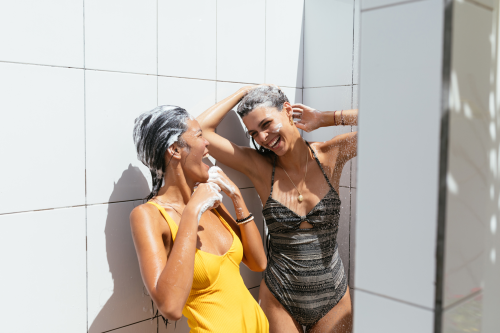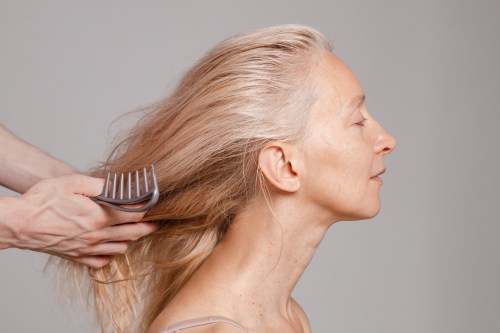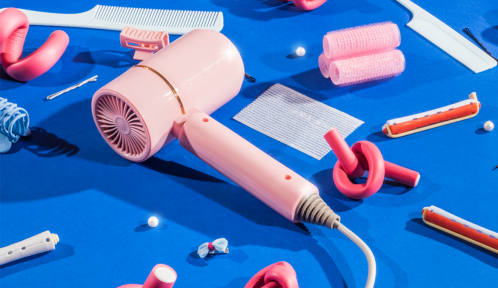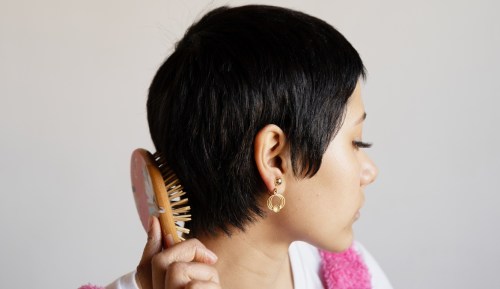Botox is best known for its wrinkle-relaxing abilities, but the neuromodulator does far more than just make fine lines disappear. It can also be used to prevent migraines, relieve jaw tension, and—my new favorite application—make your blowouts last a whole lot longer.
Experts in This Article
board-certified dermatologist in Northern California
Stephen Bracci, MD, is a board-certified laser surgeon and aesthetic medicine doctor.
board-certified hair loss doctor and hair replacement surgeon
When Botox is injected into your scalp, it helps to prevent excessive sweating along with the overproduction of oil. “I call it ‘blow-tox’ as it can help prolong a blowout,” says Caren Campbell, MD, a board-certified dermatologist in California. “It helps reduce secretions from sweat glands, so when you exercise, etc. you don’t ruin your hairstyle.”
As someone with coarse hair and a scalp that can break a sweat with astonishing ease, I’ve spent years in search of something that will help my style withstand the extra-hot temps that come along with New York City summers. Enter: Blowtox, which I tried out to see if it would help me brave the heat.
How scalp Botox works
Botox, and similar neuromodulators like Dysport and Xeomin, work by temporarily paralyzing your muscles.
“You have sweat glands, and your nervous system triggers those glands,” says Stephen Bracci, MD, a board-certified laser surgeon and aesthetic medicine doctor. “There’s muscle activity around the glands, so if you block that nerve from engaging the muscle, it doesn’t have the ability to sweat. It’s the same way that Botox works on facial muscles: We block the muscles in the forehead, for example, and you can’t raise your eyebrows and you can’t get those furrows. Same principle, just a different outcome.”
William Yates, MD, a hair loss surgeon in Chicago, adds that Botox is also sometimes used to stimulate hair growth, but research to confirm how well it actually works is lacking. “It’s used to increase the blood flow to somebody’s scalp that appears to be atrophic, meaning that it just looks like it hasn’t had any nutrients in a while,” says Dr. Yates. But, he notes that there are far more effective hair-growth tools out there. “We have so many other good things we do like platelet-rich plasma (PRP) and stem cells and things like that, that we didn’t really feel the need to do scalp Botox because we had so many other good things, but I’m not opposed to it.”
So if you’re looking to regrow hair, Botox probably shouldn’t be your first pick. But if you want to reduce the amount of sweat that comes out of your head, it’s a great option.
So where does the sweat…go?
Before trying out scalp Botox for myself, my biggest concern was what would happen to the sweat I wasn’t releasing from my head. Would my neck start getting really sweaty? Or worse, my face?
“I’ve never had anybody complain of sweating elsewhere when you block sweating someplace. Never once have I seen that or heard that happen,” says Dr. Bracci. Phew.
Considering sweat is often referred to as the body’s “natural air conditioning system,” I also wondered if I’d have a harder time cooling myself off in the heat post-treatment. But according to Dr. Bracci, there’s nothing to worry about on this front. “We have that cooling mechanism in our whole body,’ says Dr. Bracci. “So, if you block sweat in one part of the body all the other sweat glands are still going to work. You’re still going to have perspiration elsewhere, and you’re going to still have a mechanism to cool down.”
Understanding the commitment
Getting scalp Botox isn’t cheap. To do the entire scalp, you need about 100 units of Botox, or one bottle. In New York City (which is on the high end of the cost spectrum, because doctors in big cities tend to charge more for their services), a single session will run you around $1,600, says Dr. Bracci. While you may be able to find a more affordable option, keep in mind that lower costs may mean that a doctor is using less Botox, so the treatment may not be as effective as it would be if you were paying premium prices.
Another thing to note is that Botox is a temporary solution. You need to get it redone every four to six months to maintain the results on the scalp. “There’s hardly any treatment that gives you a positive result for hair that you’re not going to have to repeat,” says Dr. Yates. Dr. Bracci adds that he often has clients who do scalp Botox once a year headed into the hot and sweaty months of summer.
What it’s like getting scalp Botox
On the day of my appointment, I headed to Dr. Bracci’s office at Verve Medical Cosmetics on the Upper East Side of Manhattan. He started our session by asking me what I hoped to get out of scalp Botox (less sweat, longer-lasting blowouts), had me fill out some intake forms, and then got to work.
The appointment took about 20 minutes in total. I’d guess Dr. Bracci poked my scalp with over 100 little pricks, and they didn’t hurt at all. That’s because Dr. Bracci uses the smallest needle possible, and placed a little vibrating tool on my head each time he injected the Botox. The vibrations distracted my nerve endings from really recognizing any pain. And within minutes, I was ready to head out.
Just like with facial Botox (which can take up to a week to show visible results), scalp Botox takes a few days to kick in. I had my appointment on a Wednesday, and Dr. Bracci said I should start noticing a reduction in sweat by Sunday. He was right: I spent the weekend biking around the city in sky-high temps, and my scalp was hardly sweating at all.
Results
It’s been six weeks since my initial appointment, and I am blown away by the results. The treatment has made it exponentially easier to maintain my hair with minimal heat. Because my blowouts stay intact for longer, it means I don’t have to restyle my hair as regularly and my hair isn’t taking on nearly as much damage as it used to.
Case in point: Last week, I wore a baseball cap on a day that was 80+ degrees with 80 percent humidity. In the past, I wouldn’t have dared to do this on freshly styled hair, because the hat+heat+humidity combination has always left my hair frizzy thanks to my super-sweaty scalp. But after about an hour walking around outside, I took off my hat and my hair still looked amazing. There was a tiny bit of frizz right at the root, but otherwise, my hair looked great and my scalp wasn’t soaking wet.
For the next few months, I don’t have to worry about sweating out my style, and won’t have to constantly reapply heat for the sake of keeping it fresh. My hair is getting a bit of a break, and I am officially on the “Blowtox” bandwagon.
See what it’s like to get Botox in your face:
Sign Up for Our Daily Newsletter
Get all the latest in wellness, trends, food, fitness, beauty, and more delivered right to your inbox.
Got it, you've been added to our email list.











